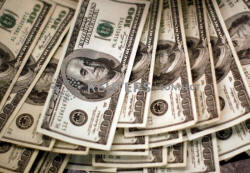U.S. dollar falls as lockdowns ease and traders turn
less averse to risk
 Send a link to a friend
Send a link to a friend
 [April 27, 2020] By
Olga Cotaga [April 27, 2020] By
Olga Cotaga
LONDON (Reuters) - The U.S. dollar fell
across the board on Monday as traders grew less averse to risk amid an
easing in coronavirus lockdowns in several countries.
The U.S. dollar was weaker against the Japanese yen and the euro as
investors turned more positive on Italy and saw the Bank of Japan
continuing to support an economy battered by the virus.
"The U.S. dollar has started the week on the back foot ... It reflects
more risk-on trading conditions at the start of this week," said Lee
Hardman, currency analyst at MUFG.
"Most notably, there was a sharp drop yesterday in the reported number
of COVID-19 fatalities in a number of countries ... which provides
further encouragement that lockdown measures are proving effective,"
Hardman said.
Credit-rating agency S&P reaffirmed on Friday Italy's BBB rating,
although many had expected a downgrade, supporting the common currency
by limiting the escalation of an economic and political crisis on the
continent.

The BoJ expanded its stimulus to help companies hit by the coronavirus
crisis, pledging to buy unlimited amount of bonds to keep borrowing
costs low as the government tries to spend its way out of the deepening
economic pain.
The dollar shed 0.4% of its value versus the Japanese yen to trade at
107.11 yen <JPY=EBS>, having fallen earlier to a two-week low of 107.05.
The euro was up 0.3% at $1.0848 <EUR=EBS>.
Traders now shift their focus to a U.S. Federal Reserve meeting ending
Wednesday and a European Central Bank (ECB) meeting on Thursday as major
central banks once again take the stage as the global economy battles
against a deep depression.
On Sunday, the Australian states of Queensland and Western Australia
said they would ease social distancing rules this week as the number of
people infected decreased, pushing the Australian dollar to a seven-week
high of 0.6469 against the U.S. dollar <AUD=D3>.
[to top of second column] |

Four thousand U.S. dollars are counted out by a banker counting
currency at a bank in Westminster, Colorado November 3, 2009.
REUTERS/Rick Wilking

Encouraged by a fall in infection rates, Germany allowed small retail stores to
reopen. Now large corporations are following suit.
Italy will also ease lockdown measures from May 4.
These measures, alongside with more positive COVID-19 data, has turned investors
towards more risky assets and abandon the safety of the dollar, analysts said. A
Reuters index that tracks the dollar against other major currencies fell below
100 for the first time since Wednesday.
Some analysts believe the move came too early, since lockdown measures are still
in place and it will take time to return to pre-COVID-19 behaviou.
Athanasios Vamvakidis, global head of G10 FX strategy at Bank of America Merrill
Lynch, remains bullish on the dollar and thinks a recovery is some way away.
"There's a clear trade-off -- either you open up and you see more infections and
more deaths or you remain closed and you kill your economy. It's no clear answer
here, there's no right or wrong. One thing is certain, we cannot eliminate the
virus unless we find a vaccine or a cure, and no matter what we d,o we cannot
have a strong recovery as long as this virus remains," Vamvakidis said.
"This is why we are a bit concerned of the market rally we have seen in risk
assets ... We're still risk-off, we still like the dollar. We believe we still
have not seen the worst off in market correction," he said.
(Reporting by Olga Cotaga; editing by Angus MacSwan, Larry King)
[© 2020 Thomson Reuters. All rights
reserved.] Copyright 2020 Reuters. All rights reserved. This material may not be published,
broadcast, rewritten or redistributed.
Thompson Reuters is solely responsible for this content.
 |